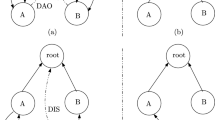Abstract
Wireless personal area networks (WPANs) are formed in a relatively small area, and coordinator that serves as a central control device plays an important role in the operation and organization of a piconet. Typical applications of WPANs include home automation systems, security systems and health monitoring systems. In these types of systems, guaranteeing seamless connectivity is very important, and communications cannot take place when the coordinator malfunctions. Thus, in the case of a breakdown, it is necessary to elect a new coordinator as soon as possible. For this reason, a distributed coordinator election scheme (DCES) is proposed that considers not only QoS support but also network connectivity in an effort to avoid possible network partition. Simulation results show that the proposed scheme can elect a new coordinator while maintaining QoS and guaranteeing connectivity for a limited period.
Similar content being viewed by others
References
Zigbee alliance. Aug. 10, 2009, http://www.zigbee.org.
Callaway E D et al. Home networking with IEEE 802.15.4: A developing standard for low-rate wireless personal area networks. IEEE Communication Magazine, Aug. 2002, 40(8): 70–77.
Won Soo Kim, Il Whan Kim, Seung Eun Hong, Chung Gu Kang. A seamless coordinator switching (SCS) scheme for wireless personal area network. IEEE Trans. Consumer Electronics, Aug. 2003, 49(3): 554–560.
Eiman Elnahrawy, Xiaoyan Li, Richard P. Martin. The limits of localization using signal strength: A comparative study. In Proc. IEEE SECON 2004, Santa Clara, USA, Oct. 4–7, 2004, pp.406–414.
Lee J Y, Scholtz R A. Ranging in a dense multipath environment using an UWB radio link. IEEE Journal on Selected Areas in Communications, Dec. 2002, 20(9): 1677–1683.
Hofmann-Wellenhof B, Lichtenegger H, Collins J. Global Positioning System: Theory and Practice. 4th Ed., Springer Verlag, 1997.
Nakano K, Olariu S. Uniform leader election protocols for radio networks. IEEE Transactions on Parallel and Distributed Systems, May 2002, 13(5): 516–526.
Li P, Jeong S G, Yoo S J. A sensing resolution-based energy efficient communication protocol for wireless sensor networks. In Proc. EUC 2006, Seoul, Korea, LNCS 4096, Aug. 1–4, 2006, pp.1058–1067.
Fetzer C, Cristian F. A highly available local leader election service. IEEE Transaction on Software Engineering, Sept. 1999, 25(5): 603–618.
Chen G, Branch J W, Szymanski B K. Local leader election, signal strength aware flooding, and routeless routing. In Proc. IEEE International Parallel and Distributed Processing Symposium (IPDPS 2005), Denver, USA, April 3–8, 2005, pp.8–15.
Nakano K, Olariu S. Randomized initialization protocols for ad hoc network. IEEE Transactions on Parallel and Distributed Systems, July 2000, 11(7): 749–759.
Hsu C S, Sheu J P. Initialization protocols for IEEE 802.11-based ad hoc networks. In Proc. IEEE ICPADS 2002, Taiwan, China, Dec. 17–20, 2002, pp.273–278.
Crow B. IEEE 802.11 wireless local area networks. IEEE Communications Magazine, Sept. 1997, 35(9): 116–126.
Chen B, Jamieson K, Balakrishnan H, Morris R. Span: An energy-efficient coordination algorithm for topology maintenance in ad hoc wireless networks. In Proc. the 6th ACM MOBICOM, Rome, Italy, Jul.16–21, 2001, pp.481–494.
Standard for part 15.4: Wireless medium access control (MAC) and physical layer (PHY) specifications for low rate wireless personal area networks (LR-WPANs). IEEE 802 Working Group. ANSI/IEEE 802.15.4, Oct. 2003.
Standard for part 15.3: Wireless medium access control (MAC) and physical layer (PHY) specifications for high rate wireless personal area networks (WPAN). IEEE 802 Working Group. ANSI/IEEE 802.15.3, 2003.
Data Sheet for tmote Sky. Aug. 10, 2009, http://www.moteiv.com/products/docs/tmote-sky-datasheet.pdf.
Hwang L J, Sheu S T, Shih Y Y, Cheng Y C. Grouping strategy for solving hidden node problem in IEEE 802.15.4 LRWPAN. In Proc. the First International Conference on Wireless Internet (WICON2005), Budapest, Hungary, Jul. 10–15, 2005, pp.26–32.
Polastre J, Hill J, Culler D. Versatile low power media access for wireless sensor networks. In Proc. ACM SenSys 2004, Baltimore, USA, Nov. 3–5, 2004, pp.95–107.
Savarese C, Rabay J, Beutel J. Locationing in distributed adhoc wireless sensor networks. In Proc. IEEE ICASSP 2001, Salt Lake City, USA, May 7–11, 2001, pp.2037–2040.
Zin Thein Kyaw, Chris Sen. Using the CC2430 and TIMAC for low-power wireless sensor applications: A power-consumption study. Aug. 10, 2009, http://focus.ti.com/lit/an/slyt295/slyt295.pdf.
Author information
Authors and Affiliations
Corresponding author
Additional information
This research was supported by the MKE (The Ministry of Knowledge Economy), Korea, under the ITRC (Information Technology Research Center) support program supervised by the IITA (Institute for Information Technology Advancement)” under Grant No. IITA-2009-C1090-0902-0019.
Rights and permissions
About this article
Cite this article
Jeong, SG., Yoo, SJ. Distributed Coordinator Election Scheme for QoS Support and Seamless Connectivity in WPANs. J. Comput. Sci. Technol. 24, 1138–1148 (2009). https://doi.org/10.1007/s11390-009-9286-4
Received:
Revised:
Published:
Issue Date:
DOI: https://doi.org/10.1007/s11390-009-9286-4




